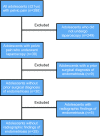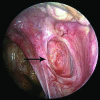Endometriosis in adolescents
- PMID: 26005317
- PMCID: PMC4432718
- DOI: 10.4293/JSLS.2015.00019
Endometriosis in adolescents
Abstract
Background and objectives: Women with endometriosis often report onset of symptoms during adolescence; however, the diagnosis of endometriosis is often delayed. The aim of this study was to describe the experience of adolescents who underwent laparoscopy for pelvic pain and were diagnosed with endometriosis: specifically, the symptoms, time from onset of symptoms to correct diagnosis, number and type of medical professionals seen, diagnosis, treatment, and postoperative outcomes.
Methods: We reviewed a series of 25 females ≤21 years of age with endometriosis diagnosed during laparoscopy for pelvic pain over an 8-year period. These patients were followed up for 1 year after surgery.
Results: The mean age at the time of surgery was 17.2 (2.4) years (range, 10-21). The most common complaints were dysmenorrhea (64%), menorrhagia (44%), abnormal/irregular uterine bleeding (60%), ≥1 gastrointestinal symptoms (56%), and ≥1 genitourinary symptoms (52%). The mean time from the onset of symptoms until diagnosis was 22.8 (31.0) months (range, 1-132). The median number of physicians who evaluated their pain was 3 (2.3) (range, 1-12). The adolescents had stage I (68%), stage II (20%), and stage III (12%) disease. Atypical endometriosis lesions were most commonly observed during laparoscopy. At 1 year, 64% reported resolved pain, 16% improved pain, 12% continued pain, and 8% recurrent pain.
Conclusions: Timely referral to a gynecologist experienced with laparoscopic diagnosis and treatment of endometriosis is critical to expedite care for adolescents with pelvic pain. Once the disease is diagnosed and treated, these patients have favorable outcomes with hormonal and nonhormonal therapy.
Keywords: Adolescent endometriosis; Atypical endometriosis; Endometriosis; Pelvic pain; Referral pattern.
Figures







References
-
- Giudice LC, Kao LC. Endometriosis. Lancet. 2004;364:1789–1799. - PubMed
-
- Carter JE. Combined hysteroscopic and laparoscopic findings in patients with chronic pelvic pain. J Am Assoc Gynecol Laparosc. 1994;2:43–47. - PubMed
-
- American College of Obstetricians and Gynecologists. Endometriosis in adolescents, ACOG Committee Opinion Number 310. Obstet Gynecol. 2005;105:921–927. - PubMed
-
- Vercellini P, Fedele L, Arcaini L, Bianchi S, Rognoni MT, Candiani GB. Laparoscopy in the diagnosis of chronic pelvic pain in adolescent women. J Reprod Med. 1989;34:827–830. - PubMed
-
- Kontoravdis A, Hassan E, Hassiakos D, Botsis D, Kontoravdis N, Creatsas G. Laparoscopic evaluation and management of chronic pelvic pain during adolescence. Clin Exp Obstet Gynecol. 1999;26:76–77. - PubMed
MeSH terms
LinkOut - more resources
Full Text Sources
Other Literature Sources
Medical
